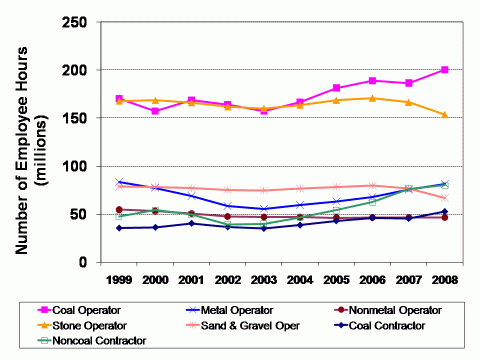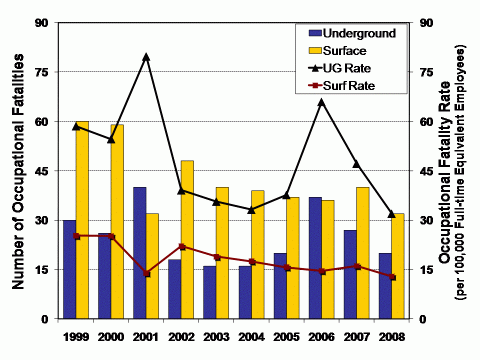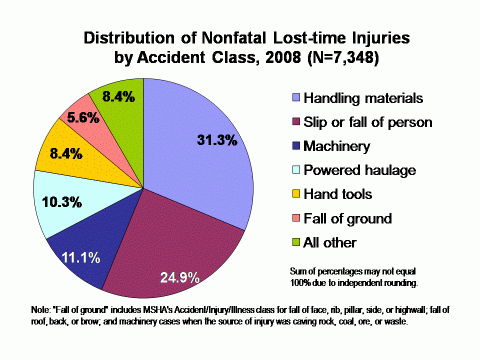Overall Mining Facts 2008 (HTML)
DHHS (NIOSH) Publication No. 2011–161
Mining Operations
In 2008, a total of 14,907 mining operations reported employment data to the Mine Safety and Health Administration (MSHA). [1] Almost half (47.8%) were sand and gravel mines, followed by stone mines (31.1%), coal mines (14.3%), nonmetal mines (4.8%), and metal mines (2.0%).
Employees
There were 273,496 mine operator employees, [2] or 274,212 full-time equivalent (FTE) [3] workers. For mine operators, 20.6% of the employee hours were for underground work locations, while 79.4% of the employee hours were for surface work locations. [4]
Of the 199,223 independent contractor employees (or 66,407 FTE workers), 36.7% were coal contractor employees and 63.6% were noncoal contractor employees.
| Commodity and Type of Employer | 1999 | 2000 | 2001 | 2002 | 2003 | 2004 | 2005 | 2006 | 2007 | 2008 |
|---|---|---|---|---|---|---|---|---|---|---|
| Coal Operator | 170.3 | 157.3 | 168.4 | 163.8 | 157.1 | 166.5 | 181.3 | 189.0 | 186.5 | 200.4 |
| Metal Operator | 83.4 | 77.4 | 68.8 | 58.5 | 55.5 | 59.5 | 63.4 | 67.9 | 75.5 | 81.4 |
| Nonmetal Operator | 54.7 | 53.1 | 50.6 | 47.5 | 46.9 | 46.9 | 46.2 | 46.4 | 46.5 | 46.5 |
| Stone Operator | 167.8 | 168.5 | 166.1 | 161.7 | 160.0 | 163.5 | 168.6 | 170.8 | 166.5 | 153.5 |
| Sand & Gravel Operator | 78.9 | 78.1 | 77.0 | 75.3 | 74.8 | 76.6 | 78.4 | 79.6 | 76.7 | 66.7 |
| Coal Contractor | 35.4 | 36.2 | 40.3 | 36.5 | 35.0 | 38.5 | 43.0 | 46.2 | 45.5 | 52.6 |
| Noncoal Contractor | 47.8 | 54.2 | 49.8 | 39.2 | 39.9 | 46.8 | 54.1 | 62.6 | 76.3 | 80.2 |
Fatalities
In 2008, there were 52 occupational mining fatalities with a rate of 16.8 [95% confidence interval (CI): 12.5, 22.0] per 100,000 FTE workers.
- The fatality rate for mine operator employees was 14.2 [CI: 9.9, 19.7] (n=35; 67.3%), while the rate for contractor employees was 27.1 [CI: 15.8, 43.4] (n=17; 32.7%.)
- Coal contractors had the highest fatality rate 48.3 [CI: 25.0, 84.4] (n=12; 23.1%), followed by coal operators 18.7 [CI: 11.1%, 29.5] (n=18; 34.6%), metal operators 13.8 [CI: 4.5, 32.2] (n=5; 9.6%), and noncoal contractors 13.2 [CI: 4.5, 32.5] (n=5; 9.6%).
- The fatality rate at underground work locations was 32.0 [CI: 19.5, 49.4] per 100,000 FTE workers (n=20; 38.5%) compared to 12.9 [CI: 8.8, 18.3] (n=32; 61.5%) at surface work locations.
| Fatalities | 1999 | 2000 | 2001 | 2002 | 2003 | 2004 | 2005 | 2006 | 2007 | 2008 |
|---|---|---|---|---|---|---|---|---|---|---|
| Underground number | 30 | 26 | 40 | 18 | 16 | 16 | 20 | 37 | 27 | 20 |
| Surface number | 60 | 59 | 32 | 48 | 40 | 39 | 37 | 36 | 40 | 32 |
| Underground rate | 58.6 | 54.7 | 79.8 | 39.1 | 35.7 | 33.2 | 37.7 | 66.0 | 47.2 | 32.0 |
| Surface rate | 25.3 | 25.2 | 13.9 | 22.1 | 18.9 | 17.5 | 15.7 | 14.6 | 16.1 | 12.9 |
Nonfatal Lost-time Injuries
There were 7,348 nonfatal lost-time injuries in 2008 (2,600 at underground and 4,748 at surface work locations). These injuries occurred at an overall rate of 2.4 [CI: 2.3, 2.4] per 100 FTE workers and resulted in a total of 382,210 days lost from work. [5]
- The underground nonfatal lost-time injury rate was greater than the surface injury rate (4.2 [CI: 4.0, 4.3] vs. 1.9 [CI: 1.9, 2.0] per 100 FTE workers).
- The back was the most frequently reported body part injured, accounting for 1,240 nonfatal lost-time injuries, 58,561 days lost from work, and 15.3% of all days lost.
- Sprains and strains were the most frequently reported nature of injury (n=3,167; 43.1%).
| Accident Class | Percent |
|---|---|
| Handling materials | 31.3 |
| Slip or fall of person | 24.9 |
| Machinery | 11.1 |
| Powered haulage | 10.3 |
| Hand tools | 8.4 |
| Fall of ground | 5.6 |
| All other | 8.4 |
Mining operations, 2008
| Commodity and Type of Employer | Underground Mining Operations [1] | Surface Mining Operations [1] | Total Mining Operations [1] |
|---|---|---|---|
| Coal | 665 | 1,464 | 2,129 |
| Metal | 105 | 188 | 293 |
| Nonmetal | 44 | 676 | 720 |
| Stone | 111 | 4,522 | 4,633 |
| Sand & Gravel | Not applicable | 7,132 | 7,132 |
| Total | 925 | 13,982 | 14,907 |
Contracting companies, 2008
| Commodity | Number of Companies |
|---|---|
| Coal | 3,467 |
| Noncoal | 6,128 |
| Total | 9,595 |
Employment characteristics, 2008
| Commodity and Type of Employer | Underground Employees [2] | Surface Employees [2] | Total Employees [2] | Underground FTE Employees [3] | Surface FTE Employees [3] | Total FTE Employees [3] |
|---|---|---|---|---|---|---|
| Coal Operator | 40,370 | 49,685 | 90,055 | 45,866 | 54,312 | 100,178 |
| Metal Operator | 5,844 | 33,282 | 39,126 | 5,842 | 34,840 | 40,682 |
| Nonmetal Operator | 2,579 | 20,454 | 23,033 | 2,725 | 20,534 | 23,260 |
| Stone Operator | 1,875 | 77,100 | 78,975 | 2,029 | 74,720 | 76,749 |
| Sand & Gravel Operator | Not applicable | 42,307 | 42,307 | Not applicable | 33,343 | 33,343 |
| Operator Total | 50,668 | 222,828 | 273,496 | 56,462 | 217,750 | 274,212 |
| Coal Contractor | 6,262 | 37,510 | 43,772 | 4,105 | 22,216 | 26,321 |
| Noncoal Contractor | 2,992 | 72,459 | 75,451 | 1,998 | 38,088 | 40,086 |
| Contractor Total | 9,254 | 109,969 | 119,223 | 6,103 | 60,304 | 66,407 |
| Total | 59,922 | 332,797 | 392,719 | 62,565 | 278,054 | 340,620 |
Mining Occupational Fatalities (per 100,000 FTE employees), 2008
| Commodity and Type of Employer | Underground Fatalities | Underground Fatality Rate | Surface Fatalities | Surface Fatality Rate | Fatalities | Fatality Rate |
|---|---|---|---|---|---|---|
| Coal Operator | 12 | 26.2 | 6 | 11.9 | 18 | 18.7 |
| Metal Operator | 3 | Not calculated | 2 | Not calculated | 5 | 13.8 |
| Nonmetal Operator | 1 | Not calculated | 1 | Not calculated | 2 | Not calculated |
| Stone Operator | 1 | Not calculated | 6 | 9.4 | 7 | 10.6 |
| Sand & Gravel Operator | Not applicable | Not applicable | 3 | Not calculated | 3 | Not calculated |
| Operator Total | 17 | 30.1 | 18 | 9.4 | 35 | 14.2 |
| Coal Contractor | 3 | Not calculated | 9 | 43.4 | 12 | 48.3 |
| Noncoal Contractor | 0 | Not calculated | 5 | 13.9 | 5 | 13.2 |
| Contractor Total | 3 | Not calculated | 14 | 24.7 | 17 | 27.1 |
| Total | 20 | 32.0 | 32 | 12.9 | 52 | 16.8 |
Nonfatal Lost-time Injuries (per 100 FTE employees), 2008
| Commodity and Type of Employer | Underground Injuries | Underground Injury Rate | Surface Injuries | Surface Injury Rate | Injuries | Injury Rate |
|---|---|---|---|---|---|---|
| Coal Operator | 2,103 | 4.6 | 768 | 1.5 | 2,871 | 3.0 |
| Metal Operator | 163 | 2.8 | 649 | 2.1 | 812 | 2.2 |
| Nonmetal Operator | 95 | 3.5 | 412 | 2.4 | 507 | 2.5 |
| Stone Operator | 33 | 1.6 | 1,593 | 2.5 | 1,626 | 2.5 |
| Sand & Gravel Operator | Not applicable | Not applicable | 550 | 1.9 | 550 | 1.9 |
| Operator Total | 2,394 | 4.2 | 3,972 | 2.1 | 6,366 | 2.6 |
| Coal Contractor | 168 | 4.1 | 313 | 1.5 | 481 | 1.9 |
| Noncoal Contractor | 38 | 1.9 | 463 | 1.3 | 501 | 1.3 |
| Contractor Total | 206 | 3.4 | 776 | 1.4 | 982 | 1.6 |
| Total | 2,600 | 4.2 | 4,748 | 1.9 | 7,348 | 2.4 |
Not calculated when N is less than 5. 95% CI for rates reported above. Totals may not sum due to independent rounding.
Data source: Publicly released employment and accident/injury/illness data collected by MSHA under 30 CFR 50.
Notes: All analyses of accident data exclude office employees. Occupational fatalities exclude all cases under 17 years of age. Further statistical methodology is available on the NIOSH Internet. Caution should be used when interpreting rates based on a small number of events.
- Mines at which only independent contractors were working did not show any employment were not counted.
- Average number of employees working at individual mines during calendar quarters of active operations (includes office workers).
- Full-time equivalent employees computed using reported employee hours (2,000 hours = 1 FTE).
- Surface work locations include surface operations at underground mines, surface operations (strip or open pit), auger, culm banks, dredge, other surface operations, independent shops and yards, and mills or preparation plants.
- Includes actual days away from work and/or days of restricted work activity. For permanently disabling injuries only, statutory days charged by MSHA were used if they exceeded the total lost workdays.
To receive NIOSH documents or more information about occupational safety and health topics, contact NIOSH at 1-800-CDC-INFO (1-800-232-4636), TTY: 1-888-232-6348, e-mail: cdcinfo@cdc.gov, or visit the NIOSH website.
See Also
- Independent Contractor Trends in the United States Mining Industry
- Independent Contractors
- Injuries, Illnesses, and Hazardous Exposures in the Mining Industry, 1986-1995: A Surveillance Report
- Mining Fact Sheets
- Mining Facts for 2000
- Noncoal Contractor Mining Facts - 2003
- Nonmetal Operator Mining Facts - 2002
- Rib Falls: A Major Ground Control Issue
- Statistics: All Mining
- Stone Operator Mining Facts - 2005
- Page last reviewed: 3/2/2015
- Page last updated: 3/26/2014
- Content source: National Institute for Occupational Safety and Health, Mining Program


 ShareCompartir
ShareCompartir


